




Posted 02 March 2013 - 09:23 AM




Posted 02 March 2013 - 10:00 AM
Don,
How confident are you that the motor, paperwork and box all "go together"? Not a challenge, just a question.
Almost every feature is inconsistent with other Pactra "Hemi" style motors! The can hole and lead wire colors are different, even the can screws are in a different place. But, you know all that already...
I presume the motor is "16D" or "Hemi 300" size? How does the motor mount in a chassis? Being can drive, it is of course mounted at the can end. Is it mounted with screws, and if so is it a vertical pattern or a horizontal pattern?
Would you mind if I make copies of your photos to put in the ISB forum elsewhere on SlotBlog?
Steve
Steve Okeefe
I build what I likes, and I likes what I build
Posted 02 March 2013 - 10:01 AM
Wow, never seen on of these, Don. Sure looks like a conglomeration of parts from different motors though.
"... a good and wholesome thing is a little harmless fun in this world; it tones a body up and keeps him human and prevents him from souring." - Mark Twain
Posted 02 March 2013 - 10:02 AM
Philippe de Lespinay
Posted 02 March 2013 - 10:14 AM
"... a good and wholesome thing is a little harmless fun in this world; it tones a body up and keeps him human and prevents him from souring." - Mark Twain
Posted 02 March 2013 - 10:45 AM
Gregory Wells
Never forget that first place goes to the racer with the MOST laps, not the racer with the FASTEST lap
Posted 02 March 2013 - 11:13 AM
Posted 02 March 2013 - 11:37 AM
Yours looks to have slotted screws holding the brush hardware down to the endbell, with hex head screws acting as the spring post on both the positive and negative posts. The motor that Don shows has large head slotted screws on the Negative posts holding down the hardware, and acting as a spring post, while the positive side has the slotted screw holding down the hardware, and the hex head screw for the spring post like your motor has. Possible this was a racer repair, or would Pactra have "fixed" one and shipped it out as new like that?
Looks to me that both motors shown are absolutely identical in every respect and that's the way they came, likely from a Hong Kong factory. The brush array is similar to that of some Johnson motors, so it is not impossible that it came from that Chinese factory on the island. However, with all the involved parties now pushing daisies, we will never know. Speculation is not truth... but good detective work does provide some light.
Pactra issued several very interesting chassis in early 1968, such as these designed for two different motors:
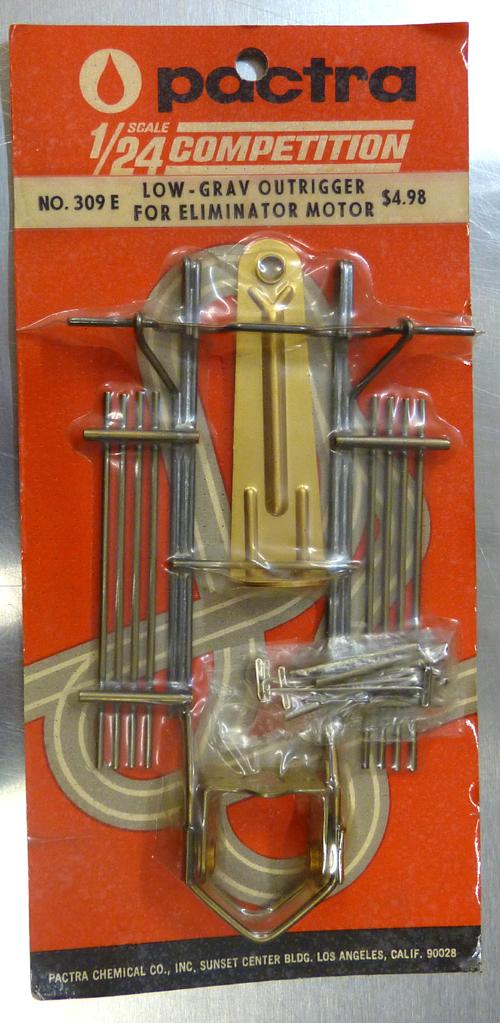
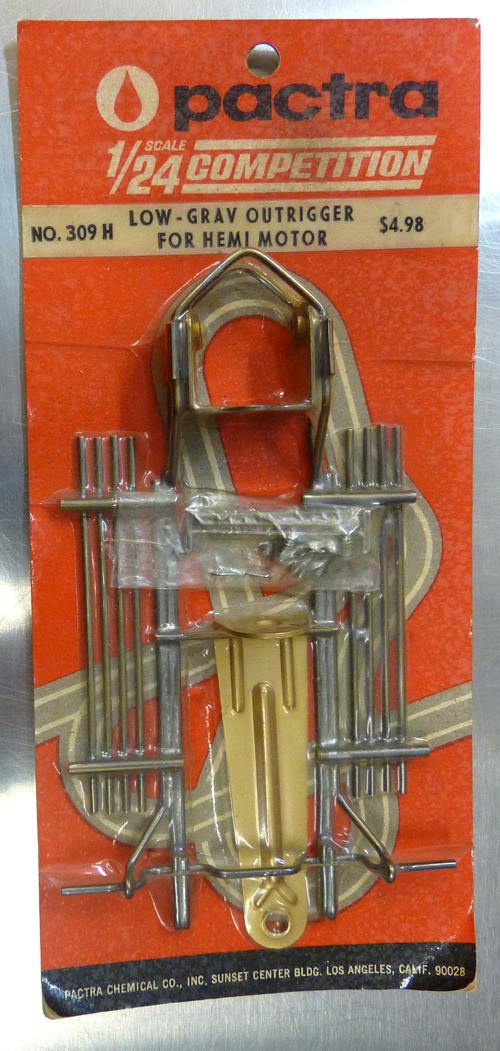
But neither is the same as the one used in those elusive Dune Buggies. Both the above have a stamped, gold anodized aluminum drop arm, designed to bolt on the motor's endbell, while the brass-sheet motor mount is bolted onto the can, forming an ISO structure pivoted at the rear-axle bearings.
The Meyers Manx chassis has a BRASS drop-arm hinged in the center of the chassis, just like a pro-racing chassis from mid-1967 as used in the Rod & Custom series.
The Eliminator motor is listed to be used in one of these packed chassis, but the Meyers Manx we have at the LASCM (one of only two genuine models I have seen so far), has a Mabuchi FT16D motor with the later oval can, that requires a different motor mount than the other loose chassis I have seen with the Eliminator motor in them, of which we have two at the LASCM. So what body came on those, the Meyers Manx or... ???
More little mysteries as you will read in the (soon to be published before I die of old age) book.
Philippe de Lespinay
Posted 02 March 2013 - 12:58 PM
Philippe,
The similar chassis I have also has the later Mabuchi 16D - it didn't really come with a body, however, except for a Porsche Carrera 6 that was just sort of plopped on top, so I don't think it was original. Can't seem to find a photo of that in stock, but here's your other Iso type chassis, a bit reinforced, but still under all that, with a Pactra hemi of some type...

Posted 02 March 2013 - 01:00 PM
BTW Don,
Thanks for expanding my vocabulary!
tergiversating present participle of ter·gi·ver·sate (Verb)
Gregory Wells
Never forget that first place goes to the racer with the MOST laps, not the racer with the FASTEST lap
Posted 02 March 2013 - 01:15 PM
Don,
This chassis is that of a standard narrow-frame, late-production Iso, illustrated below, on which as you pointed out, someone added (not very well) the outriggers and side railing, it never came that way. This is actually the way it came:
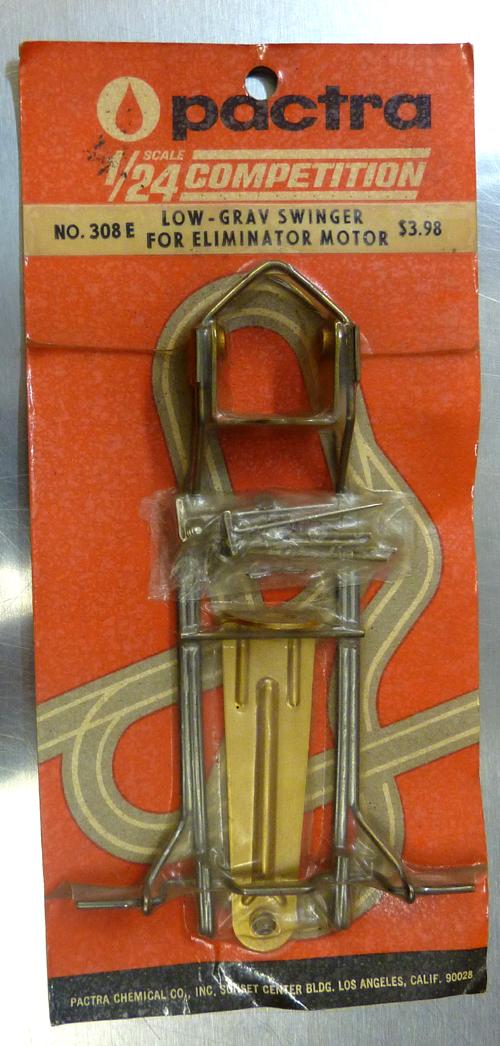
Please note that this chassis has the bracket for the Eliminator motor, but none of the production RTR models we have ever seen has one in this particular chassis design.
That chassis was used with the standard Hemi X88 motor (like on yours), in the late production of the Pactra and Competition RTRs. There was no bracket available for the Mabuchi FT16D motor.
By that time (early 1968), Pactra was only marketing RTR models, no longer kits, because the kit market had died, and most kids or adults still in the market (the few of them) no longer had the patience, now wanting instant gratification.
Here is one of the cars featuring this chassis, the Lotus 40 model by Pactra:
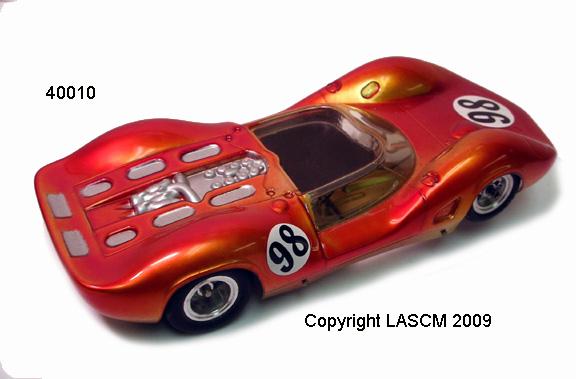

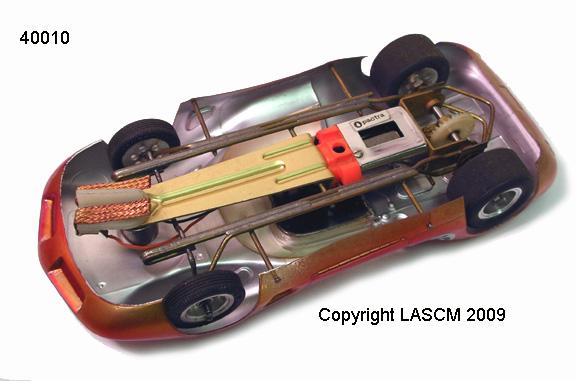
The Pactra "jail-door" chassis apparently were only marketed in a RTR model with that Meyers Manx dune buggy, and in a different form than that offered in the carded chassis kits.
Please note the new design for the guide flag, unique to these late issues Pactra cars. I need to take a pic of one to Steve Okeefe to add to his great guide listing. They existed in both black and translucent white colors.
Philippe de Lespinay
Posted 02 March 2013 - 01:46 PM


Posted 02 March 2013 - 02:13 PM
Yep, this is the correct Manx chassis, with the Mabuchi FT16DBB motor. Note the different guide, that you will find on late production Pactra RTR models.
The Pactra Manx bodies in clear plastic are not that rare (because Auto World eventually bought the inventory and sold them over the years, including some in their own kit of the Buggy using the rare Atlas chassis) but come with a black styrene interior. The RTR model came with a white styrene interior with painted-detailed driver and VW engine, and the body is of course painted in metallic red (same color as all three of their last RTR advertized in the period magazines, the very rare Ford MK4, the Lotus 40 and the BRP-Ford Indy car), and has special decals with the Isle of Man's manx on a shield, plus the "Meyers' Manx" decal up front. The clear plastic bodies apparently did not come with decals.
So if you could find a body, then someone to paint that body in the metallic red with flat-black top, you could complete your car... I also have somewhere, a copy of the decals made by Dallas Booth a long time ago. I will try making a scan for you and you could print them on decal paper...
Here is a picture of the Auto World dune buggy that used the Pactra body and the hard-to-find Atlas chassis:
Unfortunately it was painted by a person with little artistic talent, so it will receive another body before too long.
Philippe de Lespinay
Posted 02 March 2013 - 03:00 PM
The brush array is similar to that of some Johnson motors, so it is not impossible that it came from that Chinese factory on the island. However, with all the involved parties now pushing daisies, we will never know. Speculation is not truth... but good detective work does provide some light.
Philippe,
To me, the brush gear looks similar to that fitted to the round motor used in the OK Kadder 1/24 cars, or the smaller round motor known in the UK as the "Rikominx".
Joel
Posted 02 March 2013 - 03:37 PM
Hi Joel,
Indeed, and I suspect that all these motors came from the same factory in Hong Kong.
Question is, is it Johnson as I personally suspect, or yet another cloning factory???
Maybe some day, an older Chinese man, 94 years old and shaking on his walker, will let us know... ![]()
Philippe de Lespinay
Posted 02 March 2013 - 04:17 PM
Here's another one from my miscellaneous British motors - do you remember if you identified it Joel?

Hmm, we may have a match here, except for a few small details (like those can screws, still can't understand why a cheap motor would use those!) And below is the little Rikominx, on the right...

Posted 02 March 2013 - 05:09 PM
Philippe de Lespinay
Posted 02 March 2013 - 05:52 PM
Steve Okeefe
I build what I likes, and I likes what I build
Posted 02 March 2013 - 06:16 PM
Posted 02 March 2013 - 07:18 PM
Philippe de Lespinay
Posted 03 March 2013 - 10:08 AM
Steve Okeefe
I build what I likes, and I likes what I build
Posted 03 March 2013 - 10:22 AM
Don,
Thank you!
Copyright can be a thorny issue for some folks - I try to be careful and ask permission (at least the first time around) and not ASSume.
Steve Okeefe
I build what I likes, and I likes what I build
Posted 28 December 2019 - 06:48 AM
I'm bringing back this thread because I just refurbished one of these motors - maybe the one shown above, without the screws holding on the endbell. It wasn't working, so I wound up rewinding it (80 x 32, probably a milder wind than the original).
I thought it was odd that the endbell had mismatched screws for the hardware, one side with philips screws and one side with regular, but just looked at my MIB Pactra Eliminator (on the right in this photo), and it's the same thing! Why on earth would the factory do that?
Odd, non?
Don
Posted 28 December 2019 - 07:36 AM
Could it be a polarity thing? It's the way to determine which color lead wire to put on which side? The .050 motors I buy have a red dot. But again, I don't know much about motors.
Jim "Butch" Dunaway
I don't always go the extra mile, but when I do it's because I missed my exit.
All my life I've strived to keep from becoming a millionaire, so far I've succeeded.
There are three kinds of people in the world, those that are good at math and those that aren't.
No matter how big of a hammer you use, you can't pound common sense into stupid people, believe me, I've tried.
Posted 28 December 2019 - 08:03 AM
Hey Greg.....I had one of those cars...it was a Plymouth TC-3...it had Plymouth on front and Dodge on the rear....dealer asked me if I wanted it corrected and I said no...it was a good conversation starter.